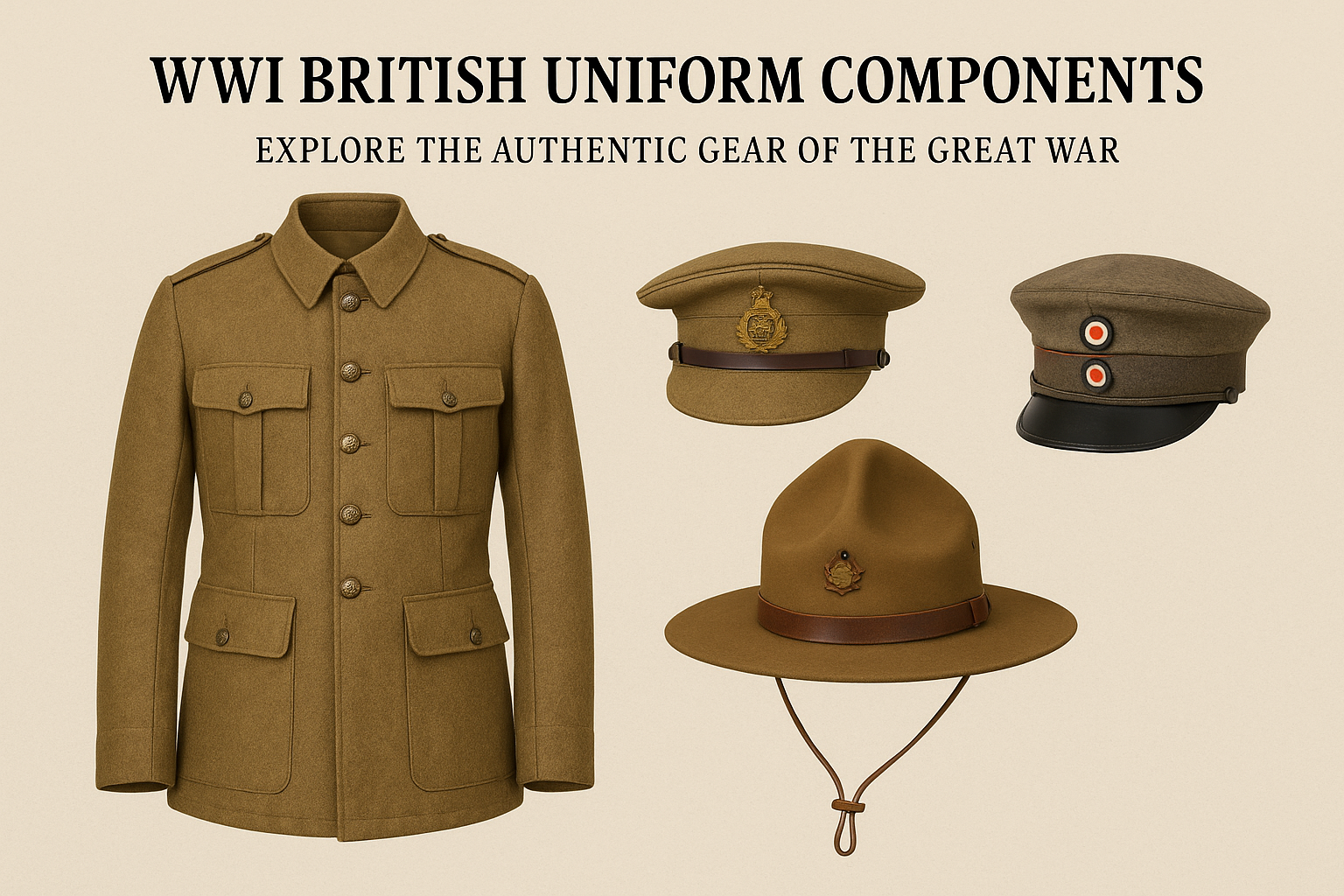
WWI British Uniform Components: Explore the Authentic Gear of the Great War
Published on Jul 02, 2025
WWI British Uniform Components: Explore the Authentic Gear of War
Introduction: The Uniforms That Marched Through History
World War I, often referred to as “The Great War,” wasn’t just a global military conflict—it was also a turning point in military fashion and functionality. The uniforms worn by British soldiers were designed not only for practicality in the muddy trenches but also to symbolize discipline and order.
In this guide, we break down the main components of the WWI British uniform, from the iconic World War One jacket to headgear options like the WW1 cap and campaign hat. We’ll also touch on German counterparts such as the Feldmutze WW1 and German WW1 officer cap, giving you a broader perspective and comparison.
1. The World War One Jacket: Backbone of the British Soldier’s Attire
The standard WWI British Service Dress jacket, also known as the 1902 Pattern tunic, was introduced just before the outbreak of war. This rugged yet refined piece became a symbol of the British Army during WWI.
Key Features:
- Made from wool serge for warmth and durability.
- A high stand-and-fall collar that could be closed during cold conditions.
- Four large patch pockets with flaps—two on the chest and two at the hip.
- Brass General Service buttons stamped with the royal crown insignia.
This World War One jacket was issued in khaki, a color chosen for camouflage in open terrain—revolutionary for its time. Unlike the bright reds and blues of the 19th-century military uniforms, khaki offered a tactical advantage.
Paddelaters.com offers historically accurate WWI jackets crafted for both authenticity and wearability.
2. WW1 Cap: The Soldier’s Everyday Headwear
When not wearing helmets, British soldiers often wore the Service Dress Cap, which became an iconic part of the WWI silhouette.
Features:
- Soft crown with a stiff peak and chin strap.
- Badge indicating regiment or rank.
- Made from the same khaki wool serge as the jacket for uniformity.
The WW1 cap was commonly seen on officers and enlisted men alike. It represented authority while providing minimal protection. Today, collectors and reenactors seek original or replica versions for display or historical events.
3. World War 1 Campaign Hat: The Broad-Brimmed Legacy
Often overlooked in mainstream war films, the World War 1 campaign hat was worn by soldiers, particularly in colonial units or during training.
Identifying Traits:
- Wide-brimmed for sun protection.
- Pinched “Montana peak” crown.
- Ventilation eyelets and leather chinstrap.
While not as widespread as the service cap, the campaign hat was favored in tropical and desert campaigns where sun and heat posed significant challenges. It’s now a popular item for reenactors portraying roles outside the European trenches.
4. The German Contrast: Feldmutze WW1 and Officer Caps
To fully appreciate the British WWI uniform, it helps to understand how it differed from its German counterpart. The Feldmutze WW1, or field cap, and the German WW1 officer cap were similar in form but distinct in design.
Feldmutze WW1:
- Soft cap with a flat crown.
- Often featured regimental or national cockades (insignia).
- Made from gray-green wool, the hallmark color of the German army.
German WW1 Officer Cap:
- More structured than the Feldmutze.
- Often had a leather peak and silver piping around the crown and band.
- A symbol of status and authority.
At Paddelaters, we provide a range of German WWI headgear replicas—ideal for comparison collectors or those interested in both sides of the conflict.
5. Accessories That Completed the Uniform
No WWI British soldier’s kit was complete without these supporting components:
Puttees:
Long strips of wool cloth wrapped around the lower leg, offering ankle support and preventing dirt from entering the boots.
Webbing and Gear:
The 1908 Pattern Web Equipment carried ammunition, water bottles, entrenching tools, and personal items.
Boots:
Ankle-length, hobnailed leather boots built for long marches across unforgiving terrain.
Each item contributed to the functionality of the British soldier's appearance while helping them survive the harsh realities of trench warfare.
6. Reenactment and Collecting: Keeping History Alive
Whether you're a reenactor, history buff, or collector, wearing or displaying accurate WWI uniform components is a way to honor the legacy of those who served. At Paddelaters.com, we specialize in crafting and curating authentic replicas of:
- World War One jackets
- WW1 caps and campaign hats
- Feldmutze WW1
- German WW1 officer caps
Our attention to detail ensures you get museum-quality pieces that tell a story.
7. Why Authenticity Matters
For museum exhibitions, living history events, or educational projects, authentic uniform components make a huge difference. Materials, stitching, button design, and color accuracy all play into whether a piece genuinely reflects its era.
That’s why Paddelaters prioritizes research and historical consultation in our production process. Every jacket and cap we offer is a tribute to the real items worn by brave men in uniform over a century ago.
Conclusion: Step Into History With Paddelaters
The WWI British uniform wasn't just a set of clothes—it was a soldier’s second skin, worn through mud, fire, and perseverance. Understanding its components, from the World War One jacket to various caps and accessories, allows us to connect more deeply with the sacrifices and stories of the past.
Whether you're reenacting, collecting, or educating others, Paddelaters.com offers historically accurate gear that helps bring the era to life. Explore our collection today and wear history with pride.
